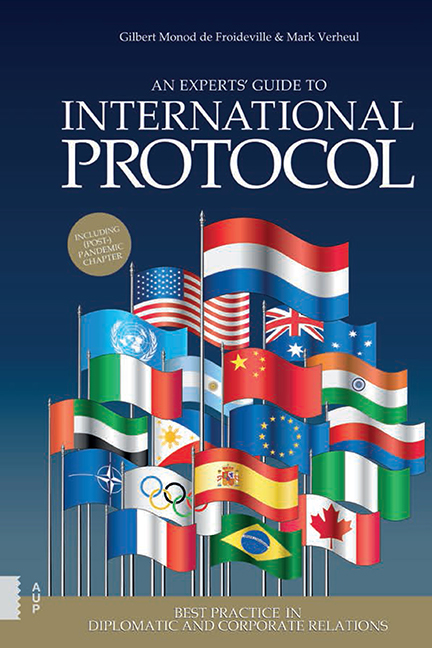Book contents
- Frontmatter
- Contents
- Preface to the original edition by His Royal Highness Prince Carlos de Bourbon de Parme
- Prologue
- Acknowledgements
- 1 International Protocol
- 2 Precedence
- 3 Seating Arrangements and Order of Processions
- 4 Flag Protocol
- 5 Invitations and Dress Codes
- 6 Gifts and Honours
- 7 Ceremonies
- 8 The Protocol Officer
- 9 Guest and Host
- 10 Protocol and Stakeholder Engagement During and after the COVID-19 Pandemic
- Authors’ Biographies
- Bibliography
- Websites
- Illustrations and Photographs
- Index
3 - Seating Arrangements and Order of Processions
Published online by Cambridge University Press: 27 May 2021
- Frontmatter
- Contents
- Preface to the original edition by His Royal Highness Prince Carlos de Bourbon de Parme
- Prologue
- Acknowledgements
- 1 International Protocol
- 2 Precedence
- 3 Seating Arrangements and Order of Processions
- 4 Flag Protocol
- 5 Invitations and Dress Codes
- 6 Gifts and Honours
- 7 Ceremonies
- 8 The Protocol Officer
- 9 Guest and Host
- 10 Protocol and Stakeholder Engagement During and after the COVID-19 Pandemic
- Authors’ Biographies
- Bibliography
- Websites
- Illustrations and Photographs
- Index
Summary
Introduction
After offering insight into the rules of precedence (préséance), in this chapter we describe how these rules may be applied to seating arrangements and order of processions. The main focus will be on table seating plans, assigning attendees to rows and blocks, and specific arrangements for public audiences and press conferences, processions, and vehicles.
Seating arrangements are not merely formalities, but have had for centuries a symbolic connotation that sometimes caused severe rank disputes. This is why the legendary King Arthur introduced the Round Table, around which he gathered with his knights. While we cannot establish whether there was ever an actual Round Table or a different table of this kind, according to tradition, everyone seated at this table had equal status, no one took precedence over the other attendees, and everyone had an opportunity to have their say. In the Middle Ages, guests invited to a banquet were often seated along one side of a long, rectangular table, leaving the other side free for clearing the table and entertainment. At the court of Louis XIV, they started arranging tables in a U-shaped plan so that there were more opportunities for interaction. Today, one can find a wide variety of table arrangements depending on the event's location and objective and its level of formality.
One should by no means slavishly adhere to préséance at all times when determining seating arrangements. The rules of precedence should be seen as an aid, since functionality prevails. A seating arrangement that conforms to protocol yet proves impractical does not contribute anything to the occasion and may well be detrimental to the success of an event that is intended to strengthen mutual relations. It is important to respect the other party's requirements. For example, avoid seating people next to one another who will be unable to converse due to language differences. In addition, one needs to take account of personal affinities or – even more important – personal antipathies and political sensitivities. A wellconsidered seating arrangement can make a very tangible contribution to an event's overall success. Age and seniority, position and rank, personal accomplishments, and gender may all influence where an individual is seated. The following section offers a basic introduction to the general guidelines for seating plans.
- Type
- Chapter
- Information
- An Experts' Guide to International ProtocolBest Practices in Diplomatic and Corporate Relations, pp. 59 - 86Publisher: Amsterdam University PressPrint publication year: 2021

